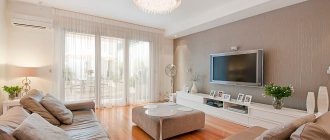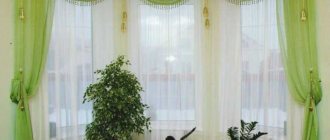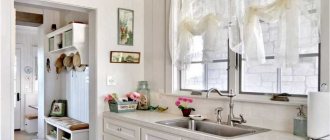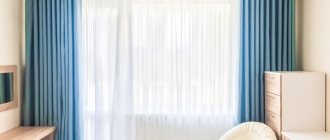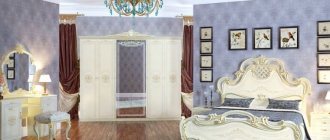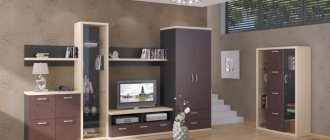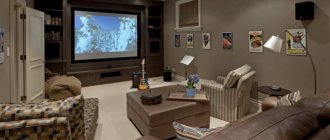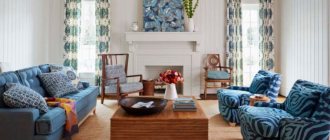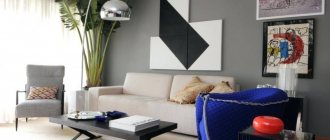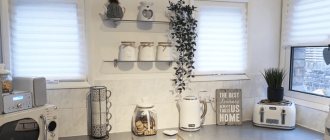Living room design features
Since the room is designed to receive guests, here you can realize your wildest fantasies. Including color and texture combinations of fabrics, as well as multi-layer compositions.
However, bright design is appropriate if the emphasis of the chosen design is on the window. If you want to visually highlight other interior items, you should give preference to a more modest option.
It is worth considering that the purpose of the living room makes its own adjustments. Unlike the bedroom, the goal here is not to close the window from daylight or artificial night light. And compared to the kitchen, the materials get dirty less. This gives greater freedom in choosing materials and design methods.
Variety of choices
The first thing a buyer pays attention to when choosing window textiles with embroidery is the design. In this case, the main role is played by the drawing.
Embroidery on tulle is done with threads matching the color of the fabric or contrasting, smooth or convex texture is possible
The topic may vary:
- Nature. Flowers, birds, butterflies, grass, flowering branches - all these and other motifs are suitable for those who love the beauty of nature.
- Geometry. Those who prefer a minimalist style will like strict motifs - stripes and chaotic lines, as well as triangles, squares and other geometric shapes.
- Rococo and Baroque. Fans of such royal styles as Rococo and Baroque will definitely like the pompous monograms and curls in the spirit of bourgeois France of the 18th century. Embroidered gold crowns and velvet curtains in deep shades would be appropriate here.
- Oriental patterns. The Turkish flavor is reflected in the models, which feature elegant oriental patterns. This option does not require curtains. If you add additional elements to them in the form of curtains or lambrequins, the interior will look overloaded.
Today, another popular option for window decoration is embroidery with rhinestones. The shimmering design looks elegant and gives the room a special, sophisticated charm.
As for the material, different fabrics can be used as the basis for the production of translucent curtains:
- Organza. Perfectly protects from sun rays.
- Veil. Weightless, very soft material, but quite dense.
- Batiste. Thin, translucent, made from linen or cotton.
- Net. Outwardly similar to fishing nets, hence the name.
- Fatin. It is a lightweight mesh fabric. Made from polyester thread. It can be matte or glossy.
- Chiffon. Very lightweight, translucent. Originally made from cotton or silk. Now synthetic analogues have appeared.
Organza Voile Batiste Mesh Tulle Chiffon
If we talk about the composition, then natural materials and synthetics are used:
- Cotton.
- Silk.
- Linen.
- Polyamide.
- Viscose.
- Elastin.
- Polyester.
In some cases, a combination of different materials is possible. For example, synthetic threads are often added to linen weave so that the fabric does not shrink after washing, is easier to iron and lasts longer.
Synthetic fabrics are easy to care for - they do not deform when washed and practically do not wrinkle
What influences the choice of tulle
The choice of tulle is determined by:
- Dimensions and shape of the room;
- Window parameters;
- Stylistic design;
- Owner's preferences.
Thus, lush curtains with an abundance of decorations will look ridiculous in a small living room. On the contrary, the right color, material and length will help brighten up the shortcomings of the room. As a result, it will look cozy and attractive.
Types of fabrics
The types of fabrics will help set the mood. Before you go shopping, you should think about what mood you want to create in the room.
Velvet and brocade embellished with guipure will help create a decadent look and luxurious style. Suitable for country cottages with large panoramic windows.
Openwork curtains with a relief pattern will help create the illusion of light and space in small rooms that do not receive enough light. These curtains will look good with a layered curtain in combination with a curtain.
Cotton and linen curtains, decorated with embroidered lace around the circumference, are suitable for the kitchen. This style is suitable for those who love everything natural and natural. When choosing openwork curtains, you need to think about other important components.
This can be plaiting, openwork tie-back for curtains, lambrequins. All these details will help balance the interior and add a touch of elegance and charm. To create a formal style, you should use pleats on the curtains. You can create them using special rings and tucks for curtains.
Types of tulle for the living room
The effect created by curtains is largely determined by the properties of the material, its transparency, ability to drape, color and other characteristics.
Therefore, before purchasing tulle, you need to assess your needs and preferences in order to weed out inconvenient options among the huge assortment. This will simplify the task and also help you make the right choice.
Modern tulle 2022
Using modern tulle 2022, you can beautifully decorate a window and concentrate the attention of others on it. It transmits daylight well into the room due to the transparency and openwork of the fabric; the texture of the tulle fabric is light and delicate.
Cotton fabrics are most often used to sew tulle for windows, but for a more luxurious design of window openings it is better to prefer silk fabrics: smooth, colored, with embroidery or guipure inserts.
Tulle material
Popular options for window decoration are:
- A mesh that attracts with its versatility and ease of care. It differs in the structure and size of the cells. Therefore, mesh tulle is convenient to match to any interior.
- Jacquard, characterized by durability and an unusual texture that decorates the interior. The material is sold in matte, glossy, plain or patterned.
- Organza fills the room with space, lightness and light due to good light transmission. However, the transparency of the material, which poorly hides what is happening in the apartment, is not always convenient for residents of the first floors.
- Veil. The material is popular due to its environmental safety, the ability to not attract static electricity and the ease of creating drapery.
- Satin that gives the room a feeling of luxury. The fabric also lends itself well to draping.
- Lace from which you can create an original window design.
Other options could be tulle, nylon, silk or muslin. Natural materials for tulle are linen and cotton. However, high shrinkage and creasing make it difficult to care for.
Types and materials of manufacture
There are several types of tulle curtains:
- The standard one is distinguished by its simplicity of design, good compatibility with drapes and curtains. It is recommended to wash such curtains by hand and iron them on a delicate cycle, placing a layer of damp gauze on top.
- Mesh can have different cell sizes. This type of tulle is not used separately because it does not protect the room well from sunlight.
- Lace is used to decorate living rooms, bedrooms, and recreation areas. There are subspecies with sewn, bobbin or embroidered openwork. The fabric may consist of lace entirely or partially.
- Embroidered is used for classics, country, minimalism. Monograms are made using silk or metallized threads. Horizontal or vertical stripes are also embroidered (or satin inserts are made).
When choosing a product, consider the material from which it is made:
- Organza is suitable for allergy sufferers because... made of polyester or silk. The product does not absorb dust and does not allow air to pass through.
- Kisey is made from silk, cotton, and linen. The canvas turns out airy and light.
- Muslin almost does not fade in the sun. It is easy to care for such curtains because dust does not settle on them.
- A thin translucent veil can last for several years. Cotton, silk or wool are used for its production.
Choosing tulle color for the living room
Interiors in conservative styles accept exclusively white tulle.
In other cases, you can experiment with the color scheme, considering:
- The tone of the walls and furniture in the room.
- Room location. It is appropriate to decorate windows facing the sunny side with curtains in cool colors. On the contrary, warm colors will suit a living room located towards the north.
- Room dimensions. Dark tulle and curtains will make a cramped space more gloomy and depressing. Such a living room can be visually expanded with white, cream or beige colors.
Creative individuals can complement the interior with tulle in non-standard shades (purple, black, burgundy).
Ready-made black and white models, as well as products with photo printing, can look stylish. The main thing is that they blend organically with the interior of the room.
Models of openwork curtains
Today you can see a wide variety of curtain models on sale: curtains with openwork lambrequin , with patterns, with wicker elements.
Lovers of romance and draperies will love models with shimmering fabrics in creamy colors. Such models are easy to drape and change the design to suit your own taste.
An openwork lambrequin represents a horizontal decorative strip at the top of the curtains. Thanks to such curtains, you can completely transform the style of the room, making it graceful and elegant.
Carved openwork lambrequins are suitable for spacious and large living rooms. They will help give the room charm, airiness and grace. Today, such curtains can be found in chocolate and beige colors.
Tulle length
Here the choice will be between the product:
- To the floor;
- To the windowsill;
- To the middle of the battery.
The first option is distinguished by aesthetics and elegance. It helps to visually lengthen the ceiling. The second is convenient for windows in niches without radiators. The third option is rarely used due to a number of limitations. In addition to the lack of a radiator, such models require a combination of several colors and mandatory decor.
Sizes and colors
The color palette of tulle products is dominated by neutral shades, pastel and light colors.
However, other colors are also available:
- White is considered a classic option. Ivory shade, milky color is used to decorate a window in a small apartment.
- Dark shades of gray are used in large rooms.
- Black color makes a depressing impression, so it is used in bright rooms with white walls, floors or ceilings.
- The chocolate shade helps create warmth and coziness, especially when paired with milky curtains.
- With the help of red, a color accent is formed (this is done by including products of suitable shades in the interior: pillows, blankets or carpets).
It is not necessary to buy a monochromatic product: it can be floral, polka dot or striped curtains. Jacquard tulle with royal patterns looks original, which is used to decorate the interior in a classic, royal style.
Depending on the purpose of the room, tulle products can reach the floor or end at the level of the window sill.
Basics of creating multi-layer compositions
To make the window design look organic, experts recommend considering the following options:
- Build a composition based on contrasting colors while maintaining a single texture;
- Combine smooth fabrics with voluminous lace;
- Use of soft color transitions;
- Classic without ruffles and an abundance of decorations;
- Combination of matte and glossy fabric;
- The choice of material where the pattern is made in combination with a weak stripe;
- Playing on different intensities of natural colors that combine with each other.
If appropriate, tulle can be accessorized. The contrast between fabrics of different colors and textures is sometimes created through lambrequins. They differ in rigidity, the presence of openwork elements and other parameters. This should be taken into account when choosing.
How to combine with other curtains
To further shade the space, tulle is combined with other types of curtains.
The combination with curtains is considered classic and is acceptable for any style. In this case, the design can be printed on only one of the curtains. It is permissible to resort to the option when the pattern on both curtains completely matches.
The most common mistakes in interior design is the use of products with different patterns. So, tulle in a small circle (circle) and floral curtains do not go together.
Tulle with Roman blinds can be used in a nursery, bedroom or living room in an Art Nouveau style. The shades of the products must either match or contrast with each other.
It is possible to combine tulle with thread curtains only through contrast. The threads of the product should be chosen large.
Design tips
When choosing tulle, you should rely on the following criteria:
- In a room without a specific style, curtains in pastel colors are optimal.
- It is better to highlight an elaborate interior with tulle in light colors.
- Plain curtains go well with patterned wallpaper.
- Tulle in subdued colors will not distract attention from the decorative elements in the living room.
- When choosing the type of fastening, you should focus on the geometry of the room.
Let's summarize: The guest's impression of visiting the house is largely determined by the living room. And a competent approach to window design will not go unnoticed.
When choosing the material, color and length of tulle, you should take into account the size of the window opening and the room. Then the curtain will not only decorate the room, but also disguise any imperfections, including low ceilings or narrow windows.
In cramped living rooms, preference is often given to simple curtains in a minimalist style. Spacious rooms open up more design possibilities, taking into account the selected furniture and wallpaper on the walls.
Features and description of openwork tulle
Tulle is a thin fabric that hides a room from prying eyes, both transmitting and blocking sunlight.
In a room curtained with such curtains, it is quite light, but not hot. Tulle curtains are easy to drape as they hold their shape well.
In addition to the openwork version, smooth tulle is also available.
Photos of new tulle designs for the living room
Chic shimmering organza tulle
Shiny and transparent organza will make any window spectacular and luxurious.
For dark rooms, organza is almost irreplaceable, because it transmits light perfectly, which makes the room visually larger. But, due to the transparency of the material, it does not protect the room well from prying eyes, especially on the first floors.
For any interior design, you can choose organza: smooth, embroidered, printed, with patterns. Caring for organza is simple, but low-quality material should be ironed.
Satin silk tulle
Don’t be surprised, silk really can be satiny: shiny on one side, smooth on the other. This tulle will fit perfectly into the design of a living room in a modern style. As a rule, it is hung with the smooth side facing the window and the satin side facing the room.
When caring for a product after washing, you cannot do without ironing; keep this in mind when planning the design of large windows with satin silk tulle. It is better to give preference to a simpler option - crocheted satin.
Small tricks
To begin with, when choosing curtains, it would be a good idea to make sketches of the room. Or look at the catalog with photographs of tulle for the hall. Remember that unwisely selected tulle can bring disharmony to the overall appearance of the room and completely ruin the design.
The large hall will be decorated with multi-layered models.
If there are arches and bulky structures, choose something simpler; straight curtains and curtains will do.
For a narrow room, a wonderful solution would be tulle with horizontal lines, hung from wall to wall.
For a low room, you need to purchase fabric with vertical stripes.
- Tulle in the interior - materials for tulle curtains and new items of modern design (100 photo ideas)
Tulle for windows: options for decorating windows with tulle in different rooms (110 photos)
- White tulle: where does white tulle fit best in a design? 105 photos of modern options
It is good to dilute a simple interior with cheerful options with metallic thread or sequins.
All these little tips will certainly help you make the right choice. However, your own taste, style and comfort criteria should be paramount - this will become a manifestation of individuality, a distinctive feature and a highlight in decorating your living space.
